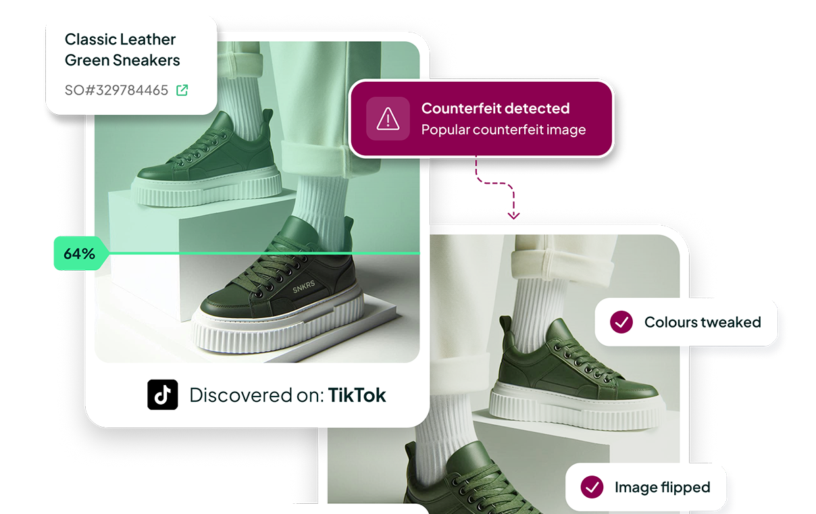Blog
When Counterfeits Go Viral: What Brands Can Learn from the Lafufu Craze
- Brand Protection

A viral counterfeit trend is putting the toy industry — and the challenges of modern Brand Protection — under the spotlight.
If you’ve been on social media lately, you’ve likely seen them: Labubus, the eccentric collectible toys adored by Gen Z and celebrities alike. But have you heard of Lafufus? These off-brand, fake, exaggerated versions of Labubu have taken TikTok and Instagram by storm. They’re uglier, cruder, cheaper, and often downright bizarre compared to their polished counterparts. And here’s the kicker: everyone knows they’re fake. Gen Z buyers are knowingly snapping up these counterfeits and flaunting them as quirky, anti-mainstream collectibles.
For businesses, this trend raises urgent questions. How did counterfeits go from being shameful imitations to celebrated artifacts? What does this mean for brands trying to protect their intellectual property while remaining culturally relevant and how do they get ahead?
Gen Z and counterfeits
There’s a saying, “Imitation is the highest form of flattery.” But in today’s complex consumer landscape, where counterfeiting, dupe culture (read more about the growth of dupe culture and its ramifications for brands here), and IP infringement intertwine, is it truly flattery, theft, or something else entirely? Lafufus are a textbook example of intellectual property theft. They borrow the core essence of Labubu but distort it into exaggerated, chaotic designs, not intentionally but as a consequence of cutting corners: lopsided eyes, bizarre smirks, and grotesque features that are strangely endearing to their audience. Some can twist their head 360°, others have eyeballs stuck on their ears.
Despite the clear-cut nature of their illegitimacy, these counterfeits have tapped into something profound: Gen Z’s affinity for irony, rebellion against mainstream culture, and a love for the unconventional. For the consumer, owning a Lafufu isn’t just about the product, or a cheaper price point, or more accessibility; it’s a statement.
The allure of imperfection
There’s no denying that Labubus strikes a chord with their audience. Labubus are already intentionally weird-looking with their pointy teeth, monster-like features, and quirky charm.
Their deliberately “ugly” designs resonate in a world obsessed with perfection. The Lafufu’s take it a step further, unintentionally, doubling down on absurdity, aligning with Gen Z’s taste for humor, self-expression, and irony.
Everything that reveals the fakeness of Lafufus seem to incite joy in Gen Z, who use this opportunity to create content on TikTok and Instagram with trending sounds. In an era marked by climate anxiety, economic uncertainty, and a relentless demand for productivity, Lafufus embody the “unserious” ethos that defines much of Gen Z humor. On social media, Lafufus are thriving along with their original counterparts. Their bizarre charm is tailor-made for TikTok trends and Instagram memes, making them cheap, accessible, and perfect for today’s fast-paced content culture (read more about influencers’ counterfeit haul videos and how to combat them here). The uglier, the more absurd and cheaper looking the Lafufu, the better it fits into this online culture of ironic detachment.
But this shift comes at a cost. By this consumer glorification of Lafufus, Gen Zrisks normalizing counterfeiting as a quirky cultural phenomenon. Counterfeits don’t exist in isolation. Every Lafufu sold diminishes the value of authentic Labubu figures, undermines the work of creators, and fuels an industry with little accountability for its environmental or ethical impacts (read more about educating Gen Z on the societal harms of counterfeits here).
The business implications
The rise of Lafufus is not a cultural anomaly. It’s not surprising to anyone who has been cruising on the highs and lows of social media trends. In fact, it serves as a wake-up call for B2C businesses navigating the complexities of IP protection while attempting to garner widespread approval for their products in a rapidly evolving marketplace.
In Europe, the threat of IP infringement was compounded when Labubu was removed from UK shelves, limiting legitimate access to the product. When fans can’t easily buy the real thing, demand doesn’t disappear — it shifts. Counterfeiters seized the opportunity, flooding the market with low-cost imitations that filled the gap, both online and across social platforms.
Counterfeiting isn’t just about this one toy line; it’s a global issue with far-reaching consequences. Here are some critical questions businesses in any industry need to consider:
- Economic impact: How can brands protect their revenue streams and intellectual property when counterfeits thrive on cultural relevance? How can one ensure their product goes viral amongst the right audience and not amongst counterfeiters and infringers?
- Brand integrity: What happens to a brand’s identity when counterfeits start dominating the conversation? How do counterfeits shape the perception of the original? Does Labubu gain or lose cultural relevance as Lafufus take over the conversation? Does it fasten up the FAD cycle or slow it down?
- Consumer connection: How can businesses foster inclusivity and accessibility without diluting their premium value proposition?
A challenge to brands
For brands like POP MART, which created Labubu, the Lafufu phenomenon is a double-edged sword. While it signifies the cultural clout of their product, it also highlights vulnerabilities to counterfeits and copycats. POP MART only recently filed for the Labubu trademark in the UK in 2024, nearly a decade after the character’s 2015 debut and only after the toy exploded in popularity [1]. Throughout this period, the brand was targeted by opportunistic counterfeiters who capitalized on its growing momentum.
Strong Brand Protection starts with securing IP early, before a product goes viral — the alternative risks a constant game of cat and mouse, where bad actors can deal significant damage to your brand image and exclusivity.
However, establishing your watertight IP portfolio is only part of the solution. You’ll still need to police online counterfeits, which is a challenging and time-intensive task. The ideal approach involves proactively monitoring and ensuring the counterfeits don’t get exposure on marketplaces and social media. As is the case with Lafufus, once they are out and have made their way to social media virality, the counterfeiting business model snowballs into an intense game of unwinnable whack-a-mole.
In the day and age of social media and short attention spans, staying culturally relevant is integral to the success of any B2C company targeting the younger generation, and staying culturally relevant requires more than just constant production of newer product lines, influencer marketing, and glorified launches. It requires constant vigilance and proactive defense of their IP. It demands creating narratives and experiences that resonate with modern audiences while reinforcing the value of the original product by ensuring companies stay ahead of the counterfeiters and infringers.
Where do we draw the line?
The Lafufu trend is a reflection of our time, much like the knockoff Tamagotchis, digital pets that required constant care, of the late ’90s. But unlike the ’90s, when finding knockoffs required effort, time, and physical legwork, Lafufus gained traction almost effortlessly. Counterfeiters kept costs low, leveraged free online platforms to reach their audience, and relied on the viral power of one funny video to ignite a wildfire of popularity. All it took was a smartphone, an internet connection, and Lafufus snowballed into a thriving market with minimal input from either creators or consumers.
But its implications are far-reaching. As consumers knowingly embrace counterfeits and accept them, how does a business educate them of the ramifications of what consumers see as a harmless buy? Is it even possible?
The Lafufu trend serves as a litmus test for how businesses respond to the counterfeit economy in an era driven by social media, irony, and fast trends. Policing counterfeits and addressing IP infringements only after they’ve gone viral is too little, too late. Consumers are drawn to virality and perceived bargains, often prioritizing trends over quality or authenticity. This makes it imperative for businesses to preempt counterfeiting at every step, ensuring that low-quality, infringing products never reach their audience. A data-backed, proactive, counterfeit and infringement strategy is the only way to get ahead of it. Because, if consumers start endorsing fakes, dupes, and infringed products, we risk losing more than just intellectual property and revenue; we risk losing the integrity of creation itself.
The importance of proactive Brand Protection
Corsearch works with some of the world’s most iconic brands to protect their intellectual property, reputation, and revenue across marketplaces, websites, social media, and more. They harness our advanced, AI-powered technology and industry expertise to detect and remove counterfeits before they saturate online marketplaces, social media, and search engine results.
Don’t wait for counterfeits to go viral. Book a demo to see how proactive Brand Protection works.
Or learn more about how brands use our AI-powered solutions.
Further anti-counterfeit resources
- An Invisible War: The Growth of Dupe Culture & Its Ramifications for Brands
- Don’t Let Tariffs Amplify Losses from Counterfeits
- Tariffs & Supply Chain Monitoring: How to Remove Counterfeits & Prevent Leakages
- How the CHIPS Act is Quietly Revolutionizing Anti-Counterfeiting in Semiconductors
References
[1] A toy takeover: what Labubu’s rise reveals about the high stakes of brand protection — The Trademark Lawyer, 2025. https://trademarklawyermagazine.com/a-toy-takeover-what-labubus-rise-reveals-about-the-high-stakes-of-brand-protection/





